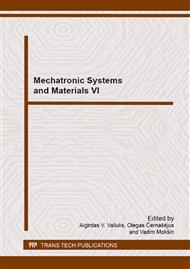[1]
K. Białas, A. Sękala, Vibration Analysis of Mechanical Systems with the Discrete-Continuous Distribution of Parameters, Mechatronic Systems and Materials IV, Solid State Phenomena, 198 (2013) 698–704.
DOI: 10.4028/www.scientific.net/ssp.198.698
Google Scholar
[2]
A. Dymarek, T. Dzitkowski, Method of active synthesis of discrete fixed mechanical systems, Journal of Vibroengineering 14(2) (2012) 458–463.
Google Scholar
[3]
A. Dymarek, T. Dzitkowski, Active synthesis of discrete systems as a tool for reduction vibration, Solid State Phenomena 198 (2013) 427–433.
DOI: 10.4028/www.scientific.net/ssp.198.427
Google Scholar
[4]
A. Dymarek, T. Dzitkowski, Reduction vibration of mechanical systems, Applied Mechanics and Materials 307 (2013) 257–260.
DOI: 10.4028/www.scientific.net/amm.307.257
Google Scholar
[5]
M.C. Smith, Synthesis of mechanical networks: the Inerter, IEEE Trans. Autom. Control. 47(10) (2002).
Google Scholar
[6]
M. Płaczek, Dynamic characteristics of a piezoelectric transducer with structural damping, Solid State Phenomena 198 (2013) 633–638.
DOI: 10.4028/www.scientific.net/ssp.198.633
Google Scholar
[7]
A. Dymarek, The sensitivity as a criterion of synthesis of discrete vibrating fixed mechanical system, Journal of Materials Processing Technology 157-158 (2004) 138–143.
DOI: 10.1016/j.jmatprotec.2004.09.011
Google Scholar
[8]
T. Dzitkowski, A. Dymarek, Active synthesis of machine drive systems using a comparative method, Journal of Vibroengineering 14(2) (2012) 528–533.
Google Scholar
[9]
T. Dzitkowski, A. Dymarek, Active synthesis of discrete systems as a tool for stabilisation vibration, Applied Mechanics and Materials 307 (2013) 295–298.
DOI: 10.4028/www.scientific.net/amm.307.295
Google Scholar
[10]
C. Grabowik, K. Krenczyk, K. Kalinowski, The hybrid method of knowledge representation in a CAPP knowledge based system, Lecture Notes in Computer Science 7209 (2012) 284–295.
DOI: 10.1007/978-3-642-28931-6_28
Google Scholar
[11]
R.C. Redfield, Dynamic system synthesis with a bond graph approach, part II: Conceptual design of an inertial velocity indicator, J. Dyn. Sys., Meas. Control. 115(3) (1993) 364–369.
DOI: 10.1115/1.2899111
Google Scholar


